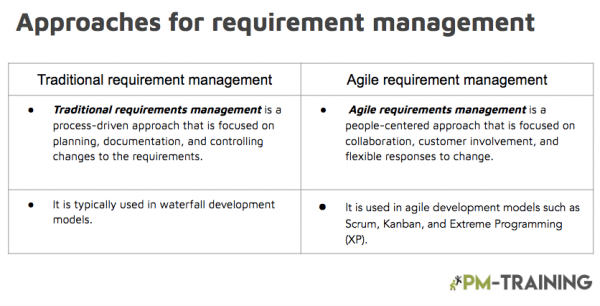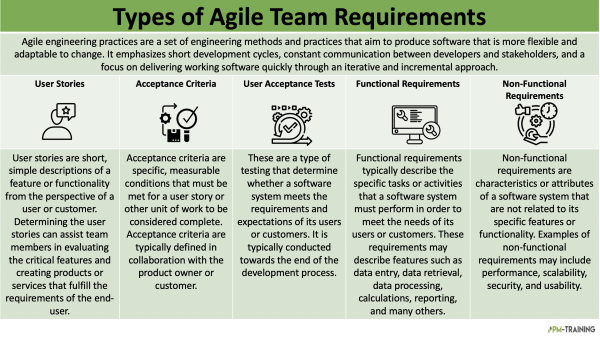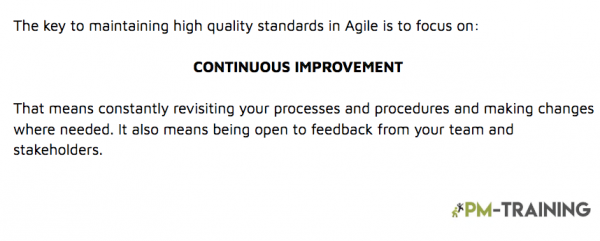In agile software development, agile team requirements management is the process of dealing with the changing needs of the customer during the software development process. Maintaining requirements in an agile way requires a different mindset and set of best practices than traditional waterfall requirements management.
Agile teams are self-organizing and cross-functional. They are typically composed of 7-9 members, including a product owner, a ScrumMaster, and a delivery team.
While Agile teams work in short cycles, they still deliver working software frequently, and they listen to their customers and stakeholders to learn what they value. Which is key.
These teams value working software more than comprehensive documentation, customer collaboration more than contract negotiation, and responding to change more than following a plan.
Their main goal is to deliver value sooner and more frequently, so we can learn and course correct based on customer feedback.
Managing Team Requirements in Agile
Requirements management is an essential part of successful software development. It is the process of documenting, analyzing, and managing the requirements of a project.
There are two main approaches to requirements management: Traditional and Agile.

An agile team will maintain requirements throughout the agile process by understanding the customer’s needs and wants, analyzing user feedback, and determining what features or changes are needed to meet the customer’s requirements.
By doing this, the agile team can adapt and change the product or application as needed to ensure the customer’s needs are always met. Agile requirements are typically defined in the form of user stories.
User stories are short, simple descriptions of a feature or functionality that is required in the software. They are often written from the perspective of the user or customer. In addition to user stories, agile requirements can also be defined in the form of product backlog items, technical tasks, or change requests.
Gathering Agile Requirements
In the Agile way, the documentation of requirements is done in a collaborative and iterative manner by the team.
The requirements are first decomposed into user stories which are then elaborated further by discussing with the customer. These user stories are then prioritized and added to the product backlog. As the product backlog is a prioritized list of user stories, it is a living document that is continuously updated by the product owner.
The product backlog can be thought of as a requirement specification for the agile team. The team then picks up user stories from the product backlog in each sprint and delivers them in an increment. The customer is involved in each sprint review to provide feedback on the product. Thus we see that Requirements management in Agile is a continuous and iterative process that is done in collaboration with the customer.

Maintain Agile Team Requirements
You may wonder how an agile team maintains requirements. But at a high level.
In a traditional waterfall development process, testers are brought in at the end to find bugs and verify that the product meets all the requirements. But in Agile, testing is done continuously throughout the development process. So how do you make sure that quality is not sacrificed in the name of speed and flexibility?
One of the main criticisms of Agile is that it leads to lower-quality software because it focuses on speed and doesn’t allow for adequate planning. While it is true that Agile does place a premium on speed, that doesn’t mean that quality has to suffer. In fact, when done correctly, Agile can actually lead to higher-quality software.

In the Agile way, development team requirements are maintained as part of the project backlog.
The backlog is a repository of development requirements (user stories) that the agile team uses to plan and execute work. As work is completed, requirements are added to the backlog and moved to the next sprint. Maintaining team requirements in an agile way requires a different mindset and set of best practices than traditional waterfall requirements management.
Best Practices for Managing Requirements in Agile Projects
The customer’s needs may change during the development process due to market conditions, changes in the business environment, or new technical possibilities. Agile teams usually have to maintain a team requirements document that outlines the features, functions, services, and products of the software they are creating. It is important for agile teams to keep their team requirements up to date so that they can deliver value to their customers quickly and efficiently.
There are a number of best practices that agile teams can follow to ensure that their team requirements are well-maintained. These include using agile documentation, tracking team requirements changes, and involving the right people in the requirements process.
You need to have a clear understanding of what quality means for your team:
- What are the criteria that your team uses to determine if a product is ready for release?
- Once you have a clear understanding of what quality means for your team, you need to make sure that all team members are on board with the definition.
- Quality cannot be sacrificed for the sake of speed or flexibility. All team members need to be aware of the definition of quality.
Can you change team requirements during a Sprint?
No changes are allowed during Sprints. Making changes to sprint requirements can be disruptive and cause delays, which means that the requirements for a given sprint should not change.
Who is responsible for maintaining communication in Agile requirements?
The product owner is responsible for maintaining the product backlog and communicating the requirements to the team. He is also responsible for ensuring that the team delivers the required functionality, quality, and value.
What are the differences between Waterfall and Agile Requirement Management?
Waterfall focuses on gathering all requirements up front, while agile focuses on gathering requirements incrementally and iteratively. Eventually, Waterfall is more rigid and focuses on documentation, while agile is more flexible and focuses on working software. Also, the waterfall is more suited for projects with well-defined requirements, while agile is more suited for projects with changing or evolving requirements.
